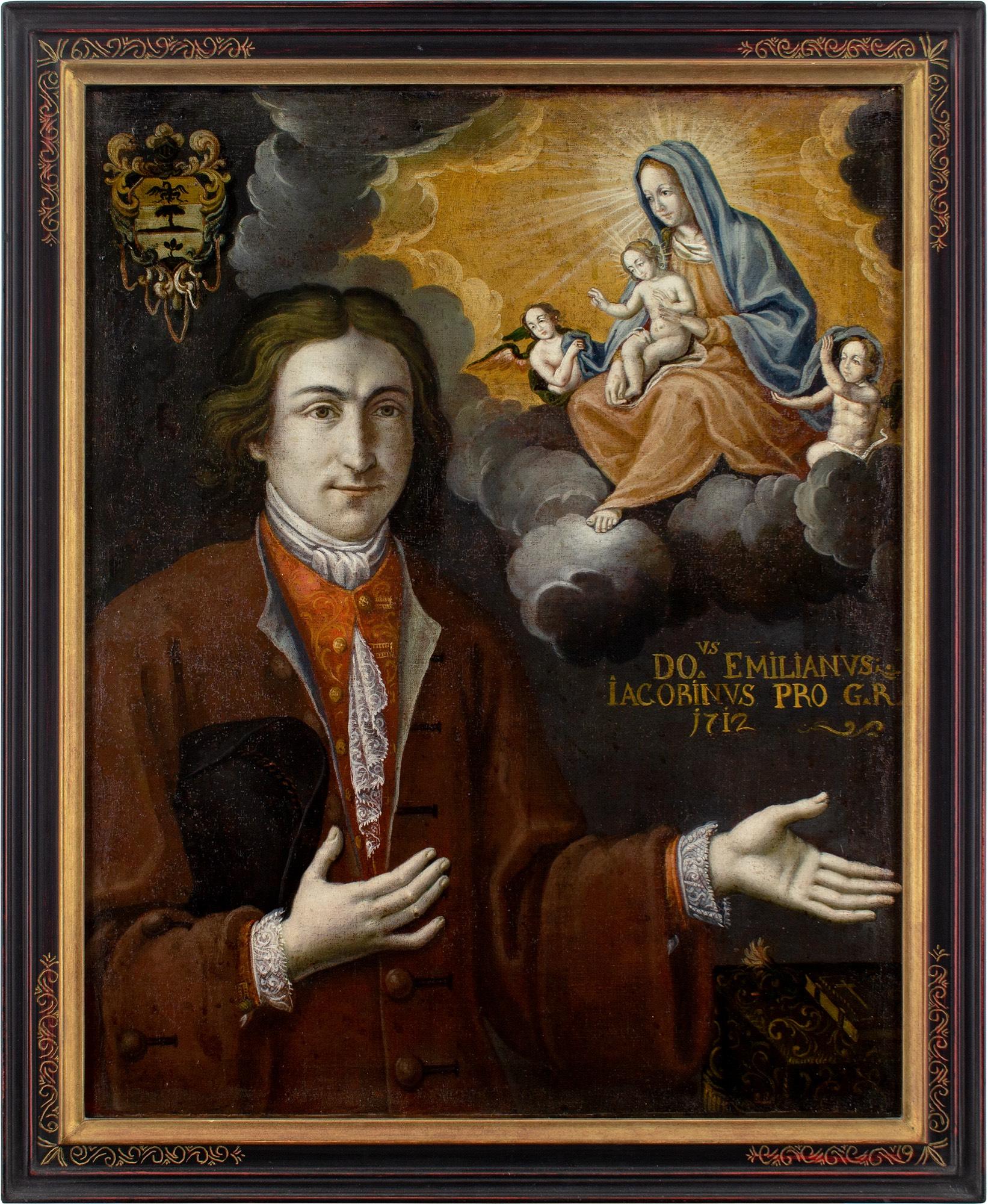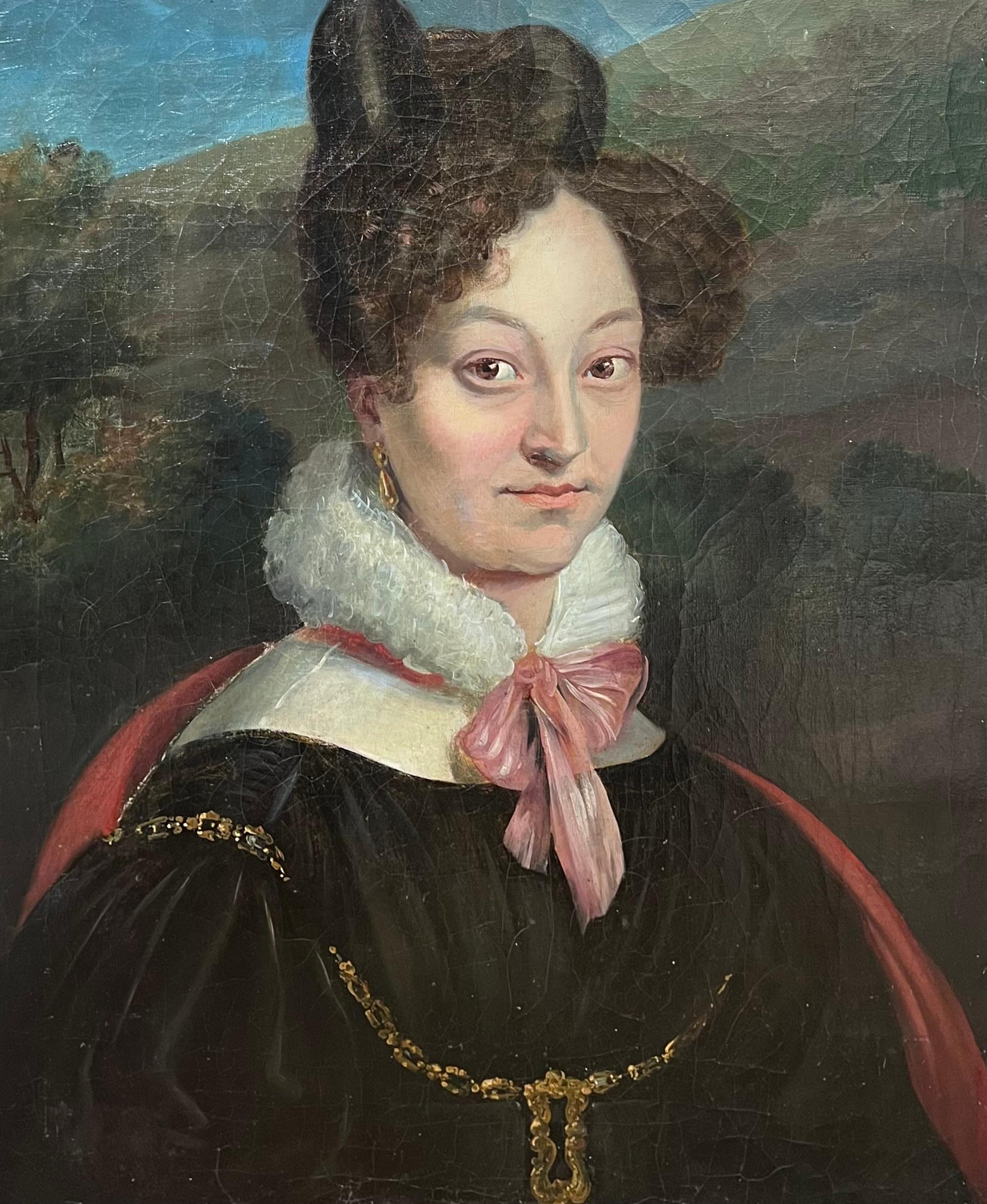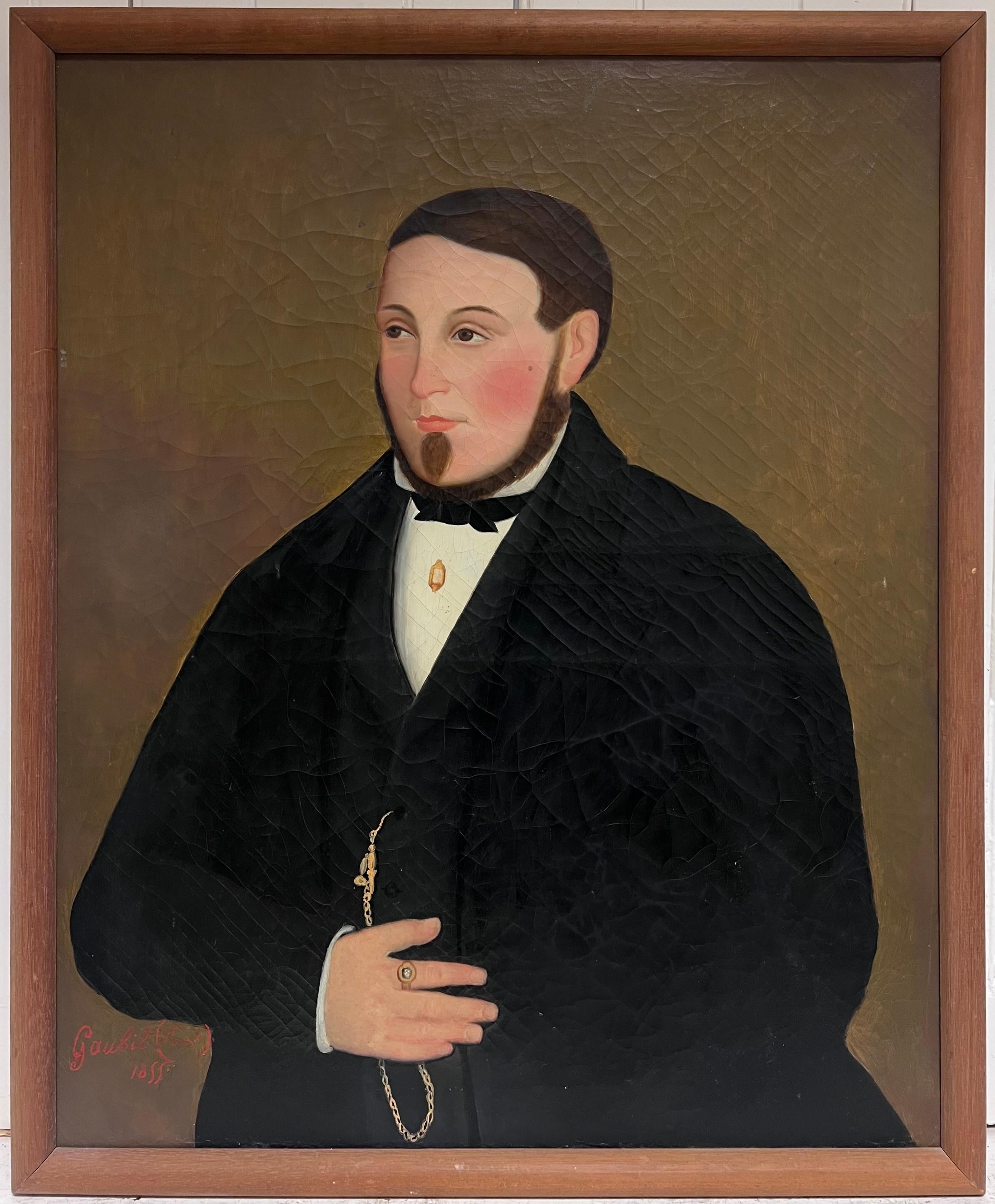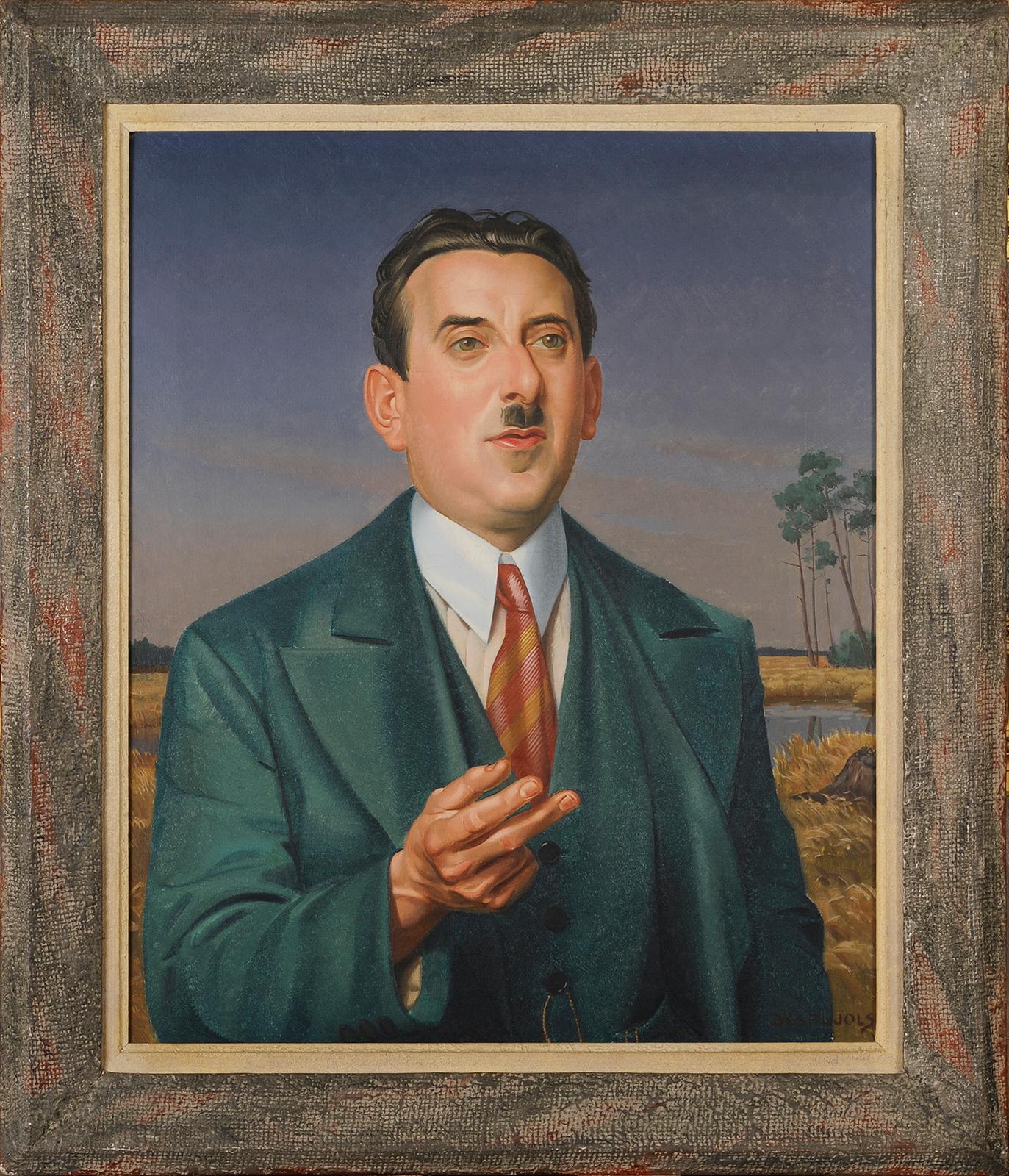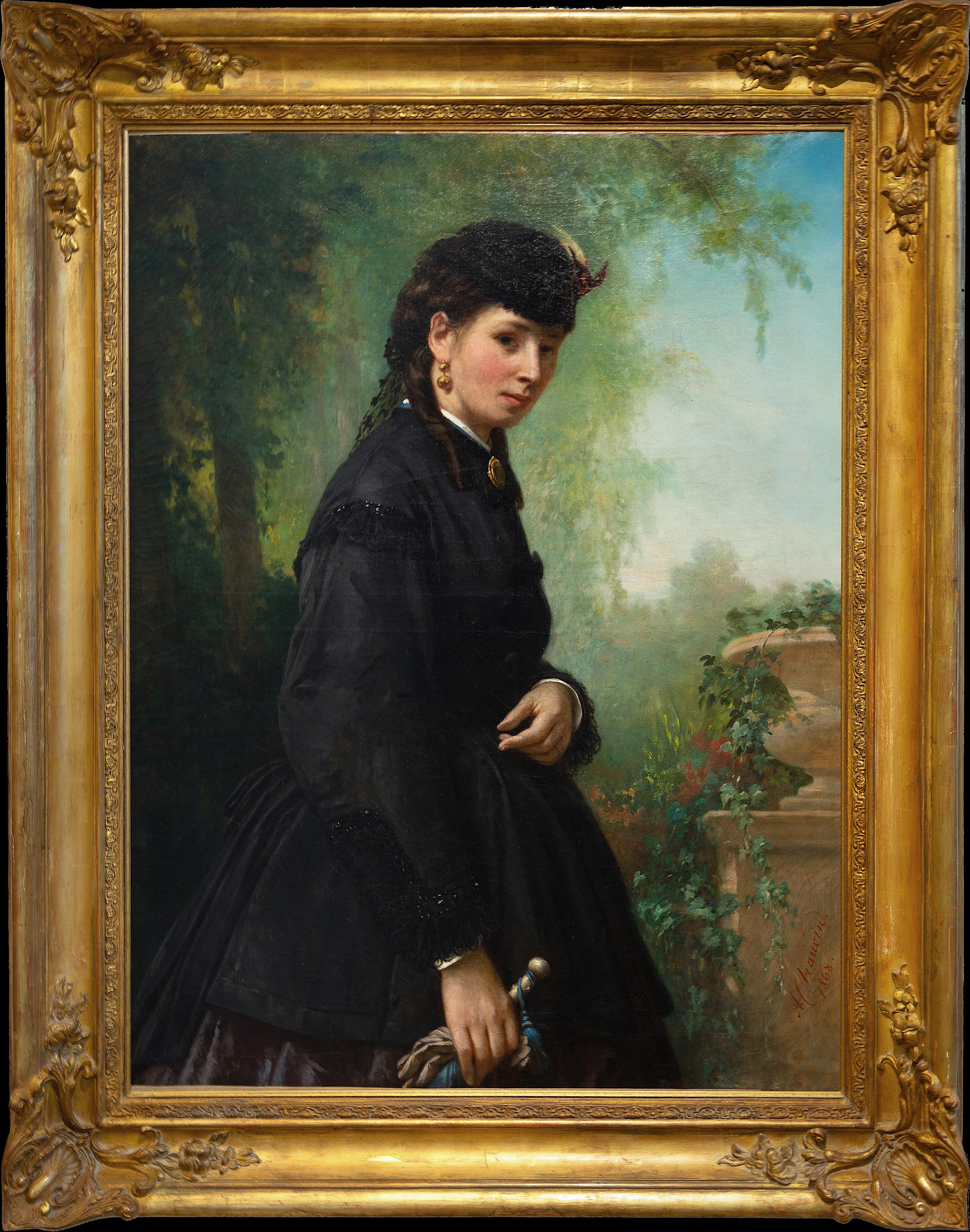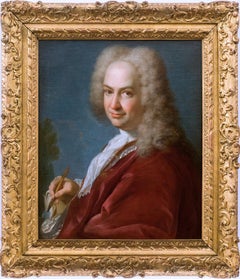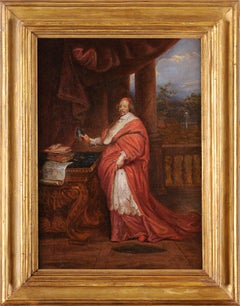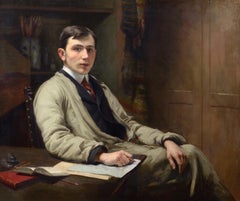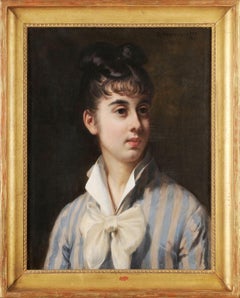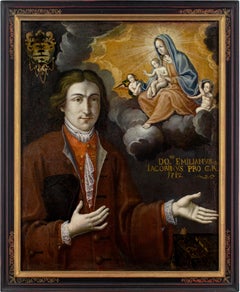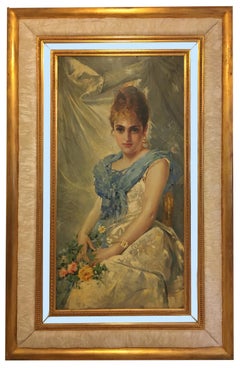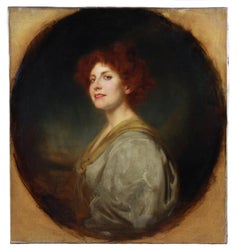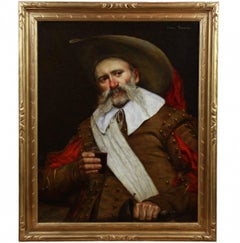Items Similar to Portrait of a priest Prémontré
Want more images or videos?
Request additional images or videos from the seller
1 of 11
UnknownPortrait of a priest PrémontréCirca 1760
Circa 1760
$8,702.46
£6,447.47
€7,400
CA$11,914.48
A$13,404.88
CHF 7,102.43
MX$165,533.31
NOK 87,068.22
SEK 83,660.56
DKK 56,303.56
Shipping
Retrieving quote...The 1stDibs Promise:
Authenticity Guarantee,
Money-Back Guarantee,
24-Hour Cancellation
About the Item
French school around 1760
Portrait of a Premonstratensian
Oil on canvas
H. 81 cm ; W. 65 cm
Traces of signature at the top left
Provenance: Private collection, Versailles
While the artist remains unknown to us, despite the signature of which a few initials still appear, we can compare him to painters such as Marianne Loir, whose portraits offer fairly similar postures and complexions.
Our Premonstratensian, holding a note in his hand, turns his face away from the axis of his bust. Is this the representation of one of the general abbots of the order? Should we consider seeing Antoine Parchappe de Vinay, holding the queens from 1758 to 1769, or his predecessor Bruno Bécourt?
Difficult to say without knowing other representations.
- Creation Year:Circa 1760
- Dimensions:Height: 31.89 in (81 cm)Width: 25.6 in (65 cm)
- Medium:
- Movement & Style:
- Period:1760-1769
- Condition:
- Gallery Location:BELEYMAS, FR
- Reference Number:1stDibs: LU1857215721252
About the Seller
3.0
Vetted Professional Seller
Every seller passes strict standards for authenticity and reliability
Established in 2017
1stDibs seller since 2022
5 sales on 1stDibs
Typical response time: 5 hours
- ShippingRetrieving quote...Shipping from: BELEYMAS, France
- Return Policy
Authenticity Guarantee
In the unlikely event there’s an issue with an item’s authenticity, contact us within 1 year for a full refund. DetailsMoney-Back Guarantee
If your item is not as described, is damaged in transit, or does not arrive, contact us within 7 days for a full refund. Details24-Hour Cancellation
You have a 24-hour grace period in which to reconsider your purchase, with no questions asked.Vetted Professional Sellers
Our world-class sellers must adhere to strict standards for service and quality, maintaining the integrity of our listings.Price-Match Guarantee
If you find that a seller listed the same item for a lower price elsewhere, we’ll match it.Trusted Global Delivery
Our best-in-class carrier network provides specialized shipping options worldwide, including custom delivery.More From This Seller
View AllPresumed artist self-portrait
Located in BELEYMAS, FR
Louis-Gabriel BLANCHET
(Versailles, 1701 – Rome, 1772)
Presumed self-portrait of the artist
Oil on canvas
H. 73 cm; W. 60 cm
Circa 1730
Originally presented in a Restoration period frame with a "Mignard" cartouche, this beautiful painting initially appeared to us as a work from northern Italy. However, it exuded a rather French form of refinement, suggesting that its artist may have assimilated a dual influence from both sides of the Alps.
We thank our colleague and friend Philippe Mendès for spontaneously and judiciously "bringing out" the name of Louis-Gabriel Blanchet, a Romanized French portraitist, whose spirit and stylistic characteristics we clearly recognize here.
Blanchet's "French" years, before his final departure for Rome in 1728, following his winning of the second Grand Prix for painting after Subleyras in 1727, are extremely poorly documented. His father, Gabriel, was valet to Blouin, himself Louis XIV's first valet at the time. According to Thierry Lefrançois, Blanchet was one of the few students of Nicolas Bertin (1667-1736), whose studio he is said to have joined in the early 1720s. At a baptism on March 24, 1724, where he was godfather, he is mentioned as a painter in the picture store of the Duke of Antin, the director of buildings between 1708 and 1736. At this time, he was probably already married to Jeanne Quément, with whom he had a daughter also named Jeanne, who would marry Nicolas Aviet, the son of a valet in the queen's wardrobe, in Versailles in 1738.
When Blanchet arrived in Rome in October 1728, he was accompanied by Subleyras, Trémolières, and Slodtz. He enjoyed the goodwill of Vleughels, the director of the Académie de France, which had been based at the Palazzo Mancini since 1725, even though the latter was not always kind to our resident. From 1732, he was under the protection of the Duke of Saint-Aignan when he took up his post as ambassador to Rome. Along with Slodtz and Subleyras, they formed a trio of friends, joined by Joseph Vernet shortly after his arrival in Rome in 1734. Slodtz and Blanchet, on the occasion of Subleyras's marriage in 1739, were there to attest that their friend was not bound by any marital commitment, and Blanchet was a witness at Vernet's wedding in 1745.
It is most likely from these early years in Rome that our portrait of the artist dates, the expression and turn of his face irresistibly reminiscent of a self-portrait. The still relatively youthful features may correspond to Blanchet's thirty-something years, and the fluffy wig was still fashionable at this time.
The painting fits well with the depiction of a young painter wanting to display both the beginnings of success and a certain simplicity or restraint. A slight smile expresses a form of assurance in this man with a gentle, sincere gaze and a face radiating a keen sense of wit. We find here the air of intimacy present in almost all of Blanchet's portraits, even those from the 1750s and 1760s, as well as an almost complicity with the viewer. The spirit of the painting is quite close to that of the presumed portrait of Bouchardon (painted around 1730) and the portrait of Pannini, painted in 1736, but it possesses a more natural quality, notably thanks to the absence of decorum. Our work exhibits the characteristics of Blanchet's paintings: elegance, luminosity (especially in the whites), vibrant and refined colors (here, the harmony of the garnet of the garment and the slate blue of the background, whose uniformity is tempered by a very sketched landscape and a grove of greenery), light complexions, rather rosy cheekbones, often full lips, and rather tight framing.
According to the Academy's rules, Blanchet's stay should have ended in the spring of 1732, but, for reasons unknown, he remained in the Eternal City until his death, as did his friend Subleyras, with whom he shared accommodation until the late 1730s. The latter regularly called upon him to collaborate on his paintings, such as The Meal at Simon's. Through Saint-Aignan's intervention, Blanchet was employed in the late 1730s by the Stuart princely family, then exiled in Italy. He notably produced copies (now lost) after Liotard of the portraits of Charles Edward and Henry Benedict, the sons of James III Stuart. The latter also commissioned three other portraits (now in the National Portrait Gallery in London), whose more formal character contrasts with the intimate spirit of Blanchet's portraits. Blanchet frequented English painters, such as the landscape painter Richard Wilson, and studied with the Scottish portraitist Katherine Read...
Category
1730s French School Portrait Paintings
Materials
Oil, Canvas
Cardinal Mazarin portrait
Located in BELEYMAS, FR
French School circa 1645
Portrait of Cardinal Mazarin - Sketch
Oil on canvas
H. 41.5 cm; W. 27 cm
Provenance: Collection of the Reverend Georges Downing Bowles (1789-1863)
Would ...
Category
1640s French School Portrait Paintings
Materials
Canvas, Oil
Portrait of young man - The artist's son
Located in BELEYMAS, FR
Auguste-Joseph Delécluse
(Roubaix 1855 - Paris 1928)
Portrait of the artist's son, Eugène Delécluse
Oil on canvas
H. 98 cm; W. 116 cm
Signed lower right
1903
Exhibition: 1903, Salon...
Category
Early 1900s French School Portrait Paintings
Materials
Canvas, Oil
Portrait of young women with a white bow
By Charles Herrmann-Léon 1
Located in BELEYMAS, FR
Charles HERRMANN-LÉON (born Léon Charles Sigismond HERRMANN)
(Le Havre 1838 - Paris 1908)
Portrait of a Young Woman
Oil on canvas
H. 54 cm; W. 41 cm
Signed and dated upper right - 18...
Category
1870s French School Portrait Paintings
Materials
Canvas, Oil
Portrait of Coraline - Belgian women
Located in BELEYMAS, FR
Auguste Adolphe CHAUVIN
(Liege, 1810 – Liege 1884)
Portrait of Coraline
Oil on canvas
Signed and dated lower right
91 x 68cm
1868
Auguste Adolphe Chauvin, born in Liège on October 2...
Category
1860s French School Portrait Paintings
Materials
Canvas, Oil
Women portraits from Napoleon III period
By Charles Chaplin
Located in BELEYMAS, FR
Charles CHAPLIN
(Les Andelys 1825 – Paris, 1891)
Portraits of women
Pair of oils on rectangular canvases
H. 60 cm; L. 50 cm
Signed
Student of Michel Martin Drolling at the École des...
Category
1850s French School Portrait Paintings
Materials
Canvas, Oil
You May Also Like
Early-18th Century French School, Ex-Voto Portrait With Emilian Jacobin
Located in Cheltenham, GB
This splendid early 18th-century French oil painting represents an ‘ex-voto’ with Emilian Jacobin and a depiction of the Virgin Mary with Christ and angels.
Ex votos are votive offe...
Category
1710s French School Portrait Paintings
Materials
Oil, Canvas
SPRING BEAUTY - Angelo Granati - Oirtrair of Oil on Canvas Painting
By Angelo Granati
Located in Napoli, IT
SPRING BEAUTY - Oil on canvas painting by Angelo Granati, Italy 2011
Gold leaf gilded, pleated silk and mirror wooden frame ext. mis. cm. 164x106.
This is his reinterpretation of pa...
Category
2010s French School Figurative Paintings
Materials
Canvas, Oil
Red-haired beauty portrait oil painting on canvas by René Avigdor 19Th Century
Located in Gavere, BE
Red-haired beauty portrait oil painting on canvas by René Avigdor 19Th Century
Rene Avigdor was born in Nice and spent his career in France.
He specialized in portraits, especiall...
Category
1890s French School Portrait Paintings
Materials
Gold Leaf
$11,007 Sale Price
20% Off
Free Shipping
Oil On Canvas, portrait of a musketeer French school 20th century
Located in Gavere, BE
Oil On Canvas, portrait of a musketeer French school 20th century
Horace Colmaire studied with Albert Roze in Amiens before joining the workshops of Léon Bonnat, Jules Adler and Ray...
Category
1920s French School Portrait Paintings
Materials
Gold Leaf
French Empire Period Portrait of Fashionable Young Lady Antique Oil Painting
Located in Cirencester, Gloucestershire
Portrait of a Young Lady
French School, early 1800's period
oil on canvas, unframed
canvas: 26 x 21 inches
Provenance: private collection, France
Condition: some crazing and pronoun...
Category
Early 19th Century French School Figurative Paintings
Materials
Oil, Canvas
$1,431 Sale Price
30% Off
1850's Large Mid 19th Century French Portrait of a Young Gentleman Signed Oil
Located in Cirencester, Gloucestershire
The French Gentleman
by Paul Goubil (French mid 19th century)
signed and dated 1855
oil on canvas, framed
framed: 30.5 x 25 inches
canvas: 29 x 24 inches
Provenance: private collecti...
Category
Mid-19th Century French School Figurative Paintings
Materials
Oil, Canvas
$1,349 Sale Price
30% Off
More Ways To Browse
Antique Hand Paint Portrait
Marianne Brown
Mr Brainwash Pele
Mucha Hamlet
Mulholland Brothers
Murakami Case
Murakami Champagne Supernova
Nan Goldin Prints Poster
National Geographic Cabinet
Nechita Peace
Nell Gwyns
Nemesio Antunez
Nichols Canyon
Nico Vrielink On Sale
Nicole Eisenman
Niko Ghika
Norman Rockwell Clock
Norman Seeff Joni Mitchell
